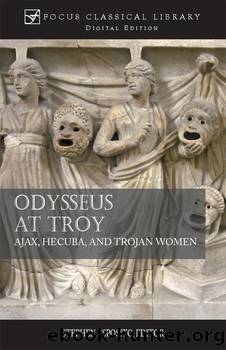Odysseus at Troy by Sophocles

Author:Sophocles
Language: eng
Format: epub
Publisher: Focus Publishing/R. Pullins Co.
Published: 2012-11-15T00:00:00+00:00
________________________________________
1 The most likely division of the eight speaking roles in Trojan Women (with their respective number of lines put in parentheses) is as follows: Actor #1 (protagonist) = Hecuba, who is on stage the entire play (436); Actor #2 (deuteragonist) = Poseidon (72), Cassandra (125), Andromache (124), and Helen (62); Actor #3 (tritagonist) = Athena (25), Talthybios (124), and Menelaos (49). The chorus of fifteen Trojan Women has some 315 lines. The play is unusual in that it has no messenger speech.
2 The reference to the ring dances of the Nereids is not purely ornamental. It contrasts with the writhing of Hecuba on stage (116, 146-52) and her memory of the magnificent dances of the women of Troy during the time of its prosperity (333). There is a like contrast in the Iliad, when the Nereids emerge onto the shore of the Troad to answer Thetisâ dirge for Patroklos and Achilles, who is now locked in the events that will lead to his death (18.35-51). In Homer the sheer music of the names of the Nereids is antiphonal to the grimness of human events on the shore of the Troad.
3 According to a Greek legend, reflected in Iliad 21.441 (and in Euripides, Andromache 1009 and Helen 1511), Apollo and Poseidon were forced to serve King Laomedon of Troy for a year, during which time they built the walls of Troy.
4 The builder of the Trojan horse. The strategem for finally taking Troy is attributed to either Athena or Odysseusâwhich amounts to the same thing.
5 These lines are bracketed by most editors as a later marginal and metrical addition to explain the obvious. But stating the obvious is a habit in the prologues of Euripides
6 Poseidonâs timely abandonment of Troy, the city whose wells he helped build, is the first expression of the grim theology of Euripidesâ Trojan Women. Without the human tribute of prayers, libations, sacrifice, and festivals, there can be no âhonorâ (time) for the gods. Even before Troyâs destruction, Athena had abandoned her, as is clear from Athenaâs silent gesture of rejection as the women of Troy bring their offerings to her temple on the citadel (Iliad 6.311).
7 This was the Zeus whose altar stood within the enclosure of a household. In the Epic Cycle, Priam was slaughtered by Achillesâ son, Pyrrhos, as he took refuge at the altar of Zeus (cf. Trojan Women 481-3).
8 That is, the two goddesses spurned by Paris, Athena and Hera, have combined to destroy Troy to avenge the insult of Paris having preferred Aphrodite in exchange for Aphroditeâs bribe of Helen. The reason for their hatred of Troy is alluded to but left unexplained in the Iliad (24.22-34; cf. 3.39 and 13.769). This background is brought explicitly into The Trojan Women by Hecuba in 924-33.
9 The principle of the division of the human spoils to be led from Troy is this: most of the women of the city, including the women who make up the chorus, are distributed by lot (kleros).
Download
This site does not store any files on its server. We only index and link to content provided by other sites. Please contact the content providers to delete copyright contents if any and email us, we'll remove relevant links or contents immediately.
| Ancient & Classical | Anthologies |
| British & Irish | Children's |
| Comedy | LGBT |
| Medieval | Regional & Cultural |
| Religious & Liturgical | Shakespeare |
| Tragedy | United States |
| Women Authors |
Cecilia; Or, Memoirs of an Heiress — Volume 2 by Fanny Burney(31871)
Cecilia; Or, Memoirs of an Heiress — Volume 3 by Fanny Burney(31852)
Dialogue by Robert McKee(4321)
The 101 Dalmatians by Dodie Smith(3452)
Bound by Hatred (The Singham Bloodlines Book 2) by MV Kasi(3024)
The Art of Dramatic Writing: Its Basis in the Creative Interpretation of Human Motives by Egri Lajos(3015)
Harry Potter and the Cursed Child - Parts One and Two by John Tiffany(3003)
The Beautiful Boys: A High School NA Reverse Harem Paranormal Bully Romance (Shadowlight Academy Book 1) by Gow Kailin(2828)
Angels in America by Tony Kushner(2596)
Carrie's War by Nina Bawden(2431)
A Clockwork Orange by Anthony Burgess(2414)
Unlaced by Jaci Burton & Jasmine Haynes & Joey W. Hill & Denise Rossetti(2325)
The Femme Playlist & I Cannot Lie to the Stars That Made Me by Catherine Hernandez(2247)
Open Book by Jessica Simpson(2205)
Drama by John Lithgow(2189)
Outside Woman (BWWM Amish Romance) by Stacy-Deanne(2083)
Terrorist Cop by Mordecai Dzikansky & ROBERT SLATER(2036)
Yerma by Federico García Lorca(2016)
Leo's Desire by Sundari Venkatraman(1897)
